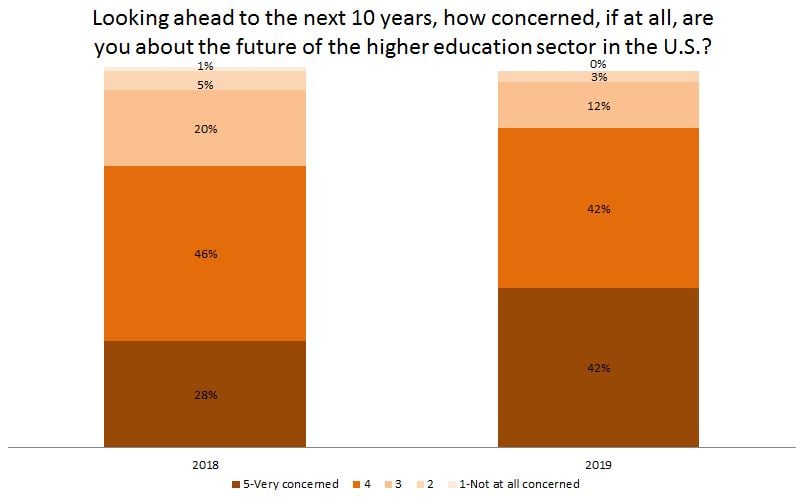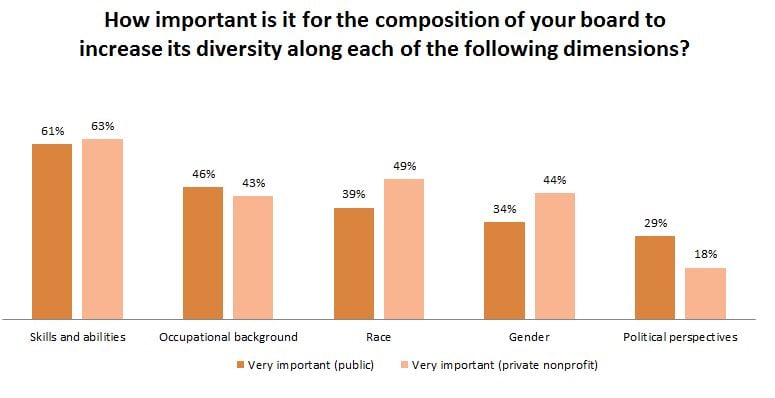You have /5 articles left.
Sign up for a free account or log in.

Istockphoto.com/baona
Trustees have grown significantly more concerned about the future of higher education in the last year, according to new polling released today that points to financial sustainability and the prices students pay as top sources of anxiety.
And trustees aren’t just worried about the sector as a whole. A majority are also concerned about the future financial sustainability of their own institutions or systems.
The data also seem to indicate college and university trustees will need to raise their level of performance, according to experts at the membership organization that released the survey, the Association of Governing Boards of Universities and Colleges. They lamented stark differences in the number of hours board members report working on corporate boards versus college and university boards.
Those on corporate boards report spending nearly two and a half times as many hours on board work as do their counterparts on higher ed boards. But higher ed board members have equal fiduciary responsibilities and are facing a swiftly changing market.
“It requires a considerable investment of time to stay abreast of change and challenges in the business model and changes in student needs and expectations,” said Merrill Schwartz, AGB senior vice president. “I’ve been working at AGB for over 20 years, and I’ve seen a real change over this period of time from trusteeship being an honorific position for many to a serious commitment and calling.”
More than four in 10 trustees, 42 percent, said they were very concerned about the future of the higher education sector in the United States over the next decade, according to the polling, which AGB commissioned from Gallup. That was 14 percentage points higher than in 2018, when only 28 percent of trustees reported being very concerned about higher ed’s future.
The share of trustees showing concern by marking either a 4 or 5 -- indicating they were somewhat or very concerned -- rose from about 74 percent in 2018 to about 84 percent in 2019.
A smaller share of trustees expressed more concern about the financial future of their own institutions or systems than about the future of the sector on the whole. Still, more than half of respondents said they were concerned about the future financial stability of the colleges, universities or systems for which they served on a board.
Concern was higher at private nonprofit institutions, where 60 percent of respondents said they were concerned or very concerned. But public institutions weren’t far behind, with about 55 percent expressing concern.
“It’s not just general concern,” Schwartz said. “Trustees are usually more concerned about the sector over all than about their own institution. This was quite significant.”
Asked what concerned them most about the future of higher education in the U.S., trustees were most likely to cite institutions’ financial sustainability and higher education’s price for students and families. Financial sustainability was cited by 38 percent of all respondents and 42 percent of those at private nonprofit institutions. The price of higher education for students was cited by 25 percent of all respondents, with little difference between public and private institutions.
| Rank | Public | Private nonprofit |
|---|---|---|
| 1 | The financial sustainability of higher education institutions (25%) | The financial sustainability of higher education institutions (42%) |
| 2 | Price of higher education for students and their families (24%) | Price of higher education for students and their families (25%) |
| 3 | Decrease in state funding of higher education (10%) | Public perception of the value of a college degree (7%) |
| 4 | Public perception of the value of a college degree (9%) | Student debt (7%) |
| 5 | Relevance of higher education in helping graduates obtain a better job/career (8%) | Relevance of higher education in helping graduates obtain a better job/career (5%) |
| 6 | Student debt (7%) | Other (5%) |
| 7 | Incoming students' preparedness for college (6%) | Equal access to higher education among different demographic groups (4%) |
| 8 | Other (6%) | Incoming students' preparedness for college (3%) |
| 9 | Equal access to higher education among different demographic groups (5%) | Decrease in state funding of higher education (2%) |
Other factors may also be contributing to heightened fears about the future.
“With increased exposure of the sector to partisanship and general polarization, numerous abrupt institutional closures and mergers, fresh proliferation of student activism, and a precipitous decline in traditional-age students looming on the horizon, the degree of board member concern is little wonder,” Henry Stoever, AGB president and CEO, wrote in a letter at the beginning of a report on the polling. “What they are doing -- or not doing -- about it is more insightful. Fully 25 percent or more of trustees assert their board spends too little time on 10 of a possible 14 higher education challenges.”
Those challenges were technology, board development and succession planning, marketing, employer relations, strategic planning, new academic programs, educational quality, public policy, fundraising, and development or succession planning for presidents.
Corporate board members reported spending about 245 hours annually on governance activities. Members of higher ed governing boards averaged just over 100 hours of trustee work per year.
“It seems apparent that many boards that aspire to overcome the challenges they face will need to raise expectations around trustee service,” Stoever wrote. He predicted larger commitments of time and energy, a commitment to learning, and a commitment to board assessment, performance and accountability will be essential.
Trustees spent the most time at board meetings, Schwartz pointed out. But many colleges and universities are exceedingly complex. She compared running one to running a city and said work outside of board meetings is important.
“The rule of thumb for students is you spend about three hours of prep time for every hour of class,” Schwartz said. “I think that’s a good rule for board meetings as well.”
Schwartz called for appointing authorities and those tasked with recruiting new board members to be transparent about expectations and make clear to trustees what they will need to do to fulfill their responsibilities.
Another organization focused on trustees, the American Council of Trustees and Alumni, emphasized a cultural change of “informed engagement” for trustees. Its president, Michael Poliakoff, called for trustees to apply their skills because they have the expertise that is well suited for discussing institutions’ program portfolio, academic rigor and skills needed to promote graduate success in the workplace.
“ACTA has long warned that the financial outlook for many colleges is bleak,” Poliakoff said in a statement. “That trustees are now realizing it is an important first step. But real culture change requires bold leadership. Above all, this means prioritizing instruction in resource allocation while trimming unnecessary expenditures in administrative, student services, and maintenance and operations categories to push down the cost of college.”
Other Findings
AGB’s polling indicates a gap between the way the public sees student debt and the way trustees see it. Just 23 percent of trustees said they thought the general public has an accurate understanding of the current debt situation in the country. Only 30 percent said the same about prospective students, and 34 percent said the same about policy makers.
On the other hand, far more trustees -- 83 percent -- felt that university administrators accurately understand the U.S. student debt situation.
Trustees largely think it’s important that they themselves communicate “accurate information about the current student debt situation to the public.” Almost six in 10 thought it was very important, with another three in 10 saying it was somewhat important.
Another notable survey finding is that the percentage of trustees agreeing that U.S. college graduates have “the skills they need to be competitive in the global economy” has fallen about 10 points since 2017, to 35 percent. Only a quarter or so, 26 percent, agreed that “colleges and universities in the U.S. have a strong understanding of what employers look for in job candidates.”
It’s notable because many college and university trustees come from the business world.
“They are mostly very successful businesspersons themselves, and have, I think, a realistic perspective of what’s needed,” Schwartz said. Trustees are also concerned about the speed at which higher education is adapting to changing workforce demands, she added.
A majority of trustees, 59 percent, said the admissions process is fair for all applicants. But their responses also indicated they might see admissions as more fair for some than for others -- 64 percent of respondents agreed or strongly agreed that applicants who have wealthy parents are more likely than others to gain acceptance to selective colleges or universities.
Nine out of 10 trustees reported their own institutions are good places for students who are members of minority racial or ethnic groups. Fewer, seven out of 10, said the same about LGBT students, although the difference is largely because more trustees said they didn’t know.
Asked about the importance of increasing board diversity, trustees were most likely to say it is very important to diversify the boards on which they served based on members’ skills and abilities, with about six in 10 trustees at both public and private nonprofit institutions saying so. Far fewer felt diversifying based on political perspectives is important -- 29 percent of trustees at public institutions and 18 percent of trustees at private nonprofit institutions said so. Trustees also diverged significantly when it came to diversifying based on race and gender (as shown in the graph below).
It’s the third year AGB has surveyed governing board members. AGB randomly selected 10,000 of its members, representative of its overall membership, for the polling. A total of 919 completed surveys.
About one in five trustees surveyed were at public institutions, while almost eight in 10 were at private nonprofit colleges or universities. Trustees surveyed were 60 percent male and 84 percent white. Roughly equal numbers identified as conservative and liberal -- about three in 10 each -- with the remaining trustees identifying as moderate.






